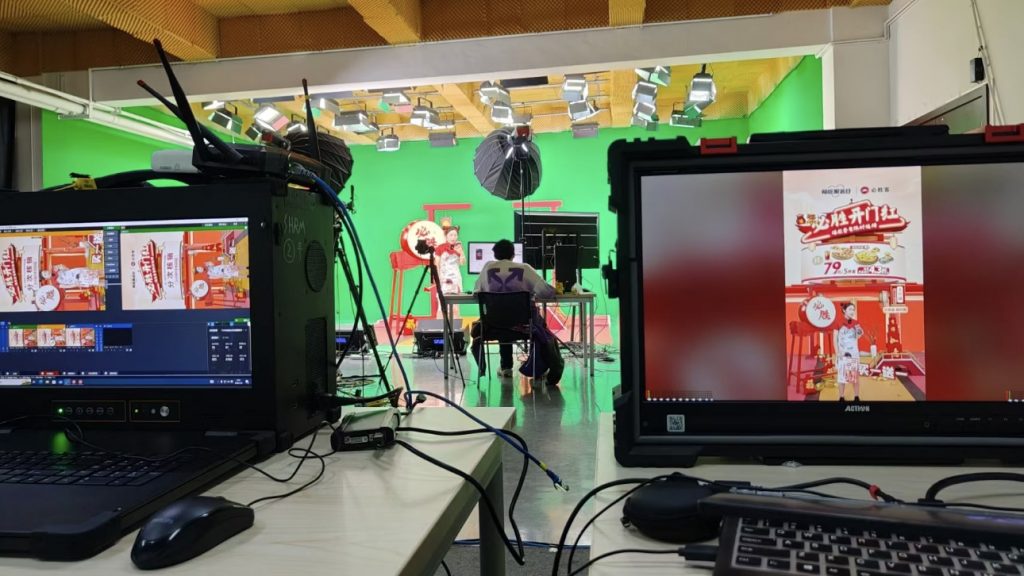Live streaming has become a way for young people in China to escape the 9-5 grind of working life. So does it live up to the promise and what makes a successful live streamer?

A young girl sold 1,000 sets of cosmetics products in only 60 seconds. She shouted out to her phone, “The lipstick has the lowest discount tonight, stocks are limited. Come and get one! Three, two, one, go!”
Cici Li is one of hundreds of thousands of live streamers in China who sell products directly to consumers through live video broadcasts. Working from makeshift studios in their homes or small rented spaces, these modern-day television hosts use smartphones and basic lighting equipment to reach millions of viewers.
She is a 22-year-old girl who just graduated from university, and her first job is as a live streamer. Reflecting on her journey, Cici said, “I first thought about becoming a live streamer during my sophomore year, which was when I started watching live streams. I found it so attractive that I would spend whole nights listening to what the streamers said and buying the products they introduced.”
Not only was she drawn to the engaging way streamers communicated, but also to their beautiful appearances. Cici explained, “They wear make-up, look beautiful, and seem so glamorous sitting in front of the camera. I also heard they can make a good fortune. That’s why I wanted to become a live streamer at that time.”
Cici’s dream job into live streaming was as her expected, and even though it being her first job, she did a good job. “When I first started out, I didn’t know much and had to figure it out on my own. But after a lot of practice, I developed my own way to attract viewers,” she shared.
As Cici’s dream of becoming a live streamer became a reality, she quickly realized that success in this field requires more than just enthusiasm. “When I first started out, I didn’t know much and had to figure it out on my own. But after a lot of practice, I developed my own way to attract viewers,” she shared her own experience.

The journey to becoming a successful live streamer is a marathon. Cici spent months to practice skills before seeing significant results.
She kept continuous learning, mastering everything from public speaking and camera presence to product knowledge and market trends. “I spent hours watching other streamers, analysing their techniques, and practicing in front of a mirror,” Cici recalls. “I even recorded myself and watched it back, no matter how cringe-worthy it was at first.”
The technical aspects of live streaming can be daunting for newcomers. High-quality cameras, microphones, and lighting equipment are essential, as is a stable internet connection.
Cici laughs as she remembers her first technical glitch, “My stream froze right in the middle of a product demonstration. I panicked, but then I realized it was an opportunity to show my audience how to handle unexpected situations gracefully.”
Content planning is another crucial aspect of preparation. Successful streamers spend hours researching their target audience, designing engaging themes, and preparing interactive segments. “It’s not just about selling products,” Cici explains. “It’s about creating an experience that viewers want to be part of.”
As Cici’s following grew, so did the complexity of her operation. She found herself diving into data analytics, studying viewer behavior, and constantly adjusting her strategy. “It’s like running a small business,” she said. “You have to work as many roles, like host, marketer, data analyst, and sometimes even tech support.”
Legal awareness is another often overlooked aspect of preparation. Streamers must navigate a complex landscape of regulations governing online content and commerce. “I spent a lot of time studying the rules to make sure I was always in compliance,” Cici notes.
Despite the challenges, Cici’s eyes light up when she talks about her career. “Becoming a successful live streamer takes time and patience,” she emphasizes. “I learn something new every day and constantly adjust my approach. The key is to stay passionate, interact genuinely with your audience, and never stop learning and improving.”

The world of live streaming is far more demanding than what the average viewer sees. Behind the seemingly effortless talk and product demos are complex, fast-paced operations that require unique skills and resilience.
A typical day for a live streamer like Cici begins hours before the broadcast. She carefully prepares her workspace, ensuring proper lighting and sound quality. She researches the day’s product lineup, memorizing key features and pricing details for dozens of items. Backstage, her team coordinates with vendors, manages inventory and monitors competitor activity.
Once the broadcast begins, the real challenge begins. For hours on end, Cici must maintain an energetic and engaging presence while juggling multiple tasks. She had to demo products, answer viewer questions in real time, and continually adjust her sales strategy based on audience reactions and buying patterns.
Jing Liu, an experienced live broadcaster with more than five years of live broadcasting experience, explains the intensity of the job, “You need to have good physical strength and quick reactions. Professional live broadcasters not only have to sell products, but also pay real-time attention to live data and traffic changes every three to five minutes. You can’t prepare scripts in advance because prices and products vary.”
This real-time data analysis is critical. Live streamers must quickly decipher audience engagement and preferences in order to make split-second decisions about which products to introduce next or how to adjust their presentation style. Jing said, “If you can capture the audience’s attention, you may be able to boost on-the-spot sales and also gain more loyal fans for future streams.”
Additionally, the most successful live broadcasters typically run long-time broadcasts, sometimes lasting 6-8 hours, and even longer during large shopping festivals. This requires not only physical endurance, but also mental toughness to stay enthusiastic and sharp throughout the broadcast.
The pressure to perform is constant. Unlike traditional retail, where a slow day may go unnoticed, every moment of a live stream is visible to viewers. A drop in energy or a few minutes without a sale can cause viewers to quickly lose interest and move on to other live streams.
This high-risk, high-energy environment sets live streaming apart from many traditional jobs. It’s a profession that requires a unique combination of salesmanship, showmanship and technical knowledge, all under the relentless gaze of a live audience.

While live streaming offers flexibility, it is far from free from a demanding work culture. The stress of capturing and maintaining viewer attention can lead to tight schedules, especially during peak shopping times.
Despite Cici’s enthusiasm in front of the camera, her eyes show tiredness. She shares the less glamorous side of her job, “During the holidays, everyone in the house is swiping their phones to watch a live stream that is us.”
This intense schedule is designed to maximize ratings and sales.
Streamers often find themselves working evenings, weekends, and holidays when viewers are most likely to be online. Cici says, “Talking for long periods of time can be exhausting, and by the end of a three- or four-hour live broadcast, the brain is drained. Staying up late is common because the audience traffic is better in the evening and early morning.”
While they’ve escaped the traditional 9-5 working hours, they’ve entered a world where they work nearly every waking hour during peak season.
For those who succeed, the potential financial rewards can be substantial. Depending on sales, the best top streamers can earn £350 million a year.
For many young Chinese facing a tough job market and limited opportunities in traditional industries, this earning potential is a major draw. The live streaming e-commerce market size of £490 billion in 2023, the industry is still releasing growth signals, it is expected that by 2025, this figure will exceed £700 billion according to the 2023 China Live Streaming E-commerce Industry Research Report.
However, this kind of high income is not for everyone. Not everyone can succeed in this industry. Cici’s Manager, Issac Luo said, “You usually need two to three months to see if someone has the potential to be a streamer. Even professional hosts might struggle with selling goods because live streaming requires managing the entire streaming rhythm and knowing when to be fast or slow.”
And successful live streamers need to possess a unique combination of skills, including salesmanship, showmanship and technical acumen. They must be charismatic in front of the camera while analyzing data in real time to adjust their sales strategies.
The competition in the live broadcast industry is extremely fierce. Wang Li, an anchor who has been in the live-streaming industry for three years, said, “It was really hard in the beginning. It took me nearly a year to accumulate 10,000 fans. During that time, I often wondered if I was right for this business.”
Thousands of anchors on the platform are competing for the attention of a limited number of viewers. It often takes newcomers months or even years to build up a stable fan base. Many give up in the process.
“Persistence is the key,” Wang Li adds. “You have to be enthusiastic every day, even if there are only a few dozen people watching you live. Slowly, you will find your own style and learn what your audience likes.”

Live streaming is not just about selling products, it’s about building a personal brand. Successful anchors tend to cultivate a specific audience, who not only come to shop, but also attracted by the personality of the anchor.
This intimate anchor-viewer relationship also brings unique pressures. Many anchors say they feel like they have to look perfect at all times, as any small misstep can be magnified on social media.
Nonetheless, for successful anchors like Cici, live streaming offers a unique career path. It allows them to utilize their talents and enjoy the flexibility of working while earning a substantial income.
But Cici also gave advice to young people who want to enter the industry. She said, “It’s not an easy job. It takes a lot of hard work and dedication. But if you really love it, this job can bring you unimaginable fulfillment.”
The success of live streaming is not just about selling products, but also about connecting with viewers.
Experienced live streamers learn to adjust their approach based on the demographics and preferences of their viewers. They may recommend high-value products to urban professionals, or they may focus on affordable products for students and young workers.
While live streaming may seem glorious, the industry also faces unique challenges. One of them is dealing with negative comments, a problem that almost every live streamer experiences.
Perhaps the most challenging aspect of becoming a live streamer is developing the mental fortitude to handle criticism and maintain a positive attitude. “The first time I received negative comments, I was devastated,” Cici admits. “But I learned to see them as opportunities for improvement rather than personal attacks.”
The commonality of this problem comes from the real-time interactive nature of live streaming platforms. Live streaming is usually carried out on specialised platforms, such as Taobao Live, Tiktok or others. Viewers can send comments in real time, which immediately appear on the live streaming interface and are visible to both the host and other viewers.
While this immediacy adds a sense of interactivity, it also provides a channel for negative comments to spread quickly. Cici shared her experience that, “Being a live streamer, you may encounter unkind comments daily, but you must stay composed .”
Moreover, the interactive nature of real-time means that live streamers must be able to think and react quickly. Cici said, “We can’t take negative comments too seriously. We still have to sell the products, and manage the audience’s emotions and maintain a positive atmosphere in the room.”
Even though there are challenges to be a successful live streamer. Looking ahead, Cici is optimistic about the development of the industry, “There is still a lot of room for development in live streaming. With the advancement of technology, we may see more innovative ways of interaction and sales models. But the key is to always focus on user needs and provide truly valuable content and products.”
